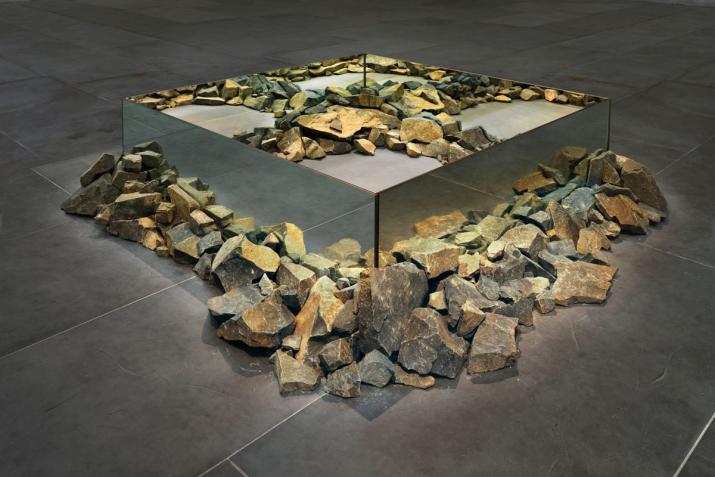Pierre Jardin’s eagerly anticipated visit to see Alexander von Humboldt’s Stone and Mineral Collection at the Museum für Naturkunde in Berlin did not unfold as expected. Having prepared for the pilgrimage by reading Andrea Wulf’s marvelous The Invention of Nature, PJ set out seeking the pleasures of the Wunderkammer, but was soon metamorphosed under the weight and pressure of the collection’s desire to capture, classify, and display mineral specimens. The gold standard here is the “type sample,” a sample used to describe a type of mineral for the very first time. Humboldt’s determination to mine the diversity of the Earth’s materials and processes, to ferret out the hidden wealth of Nature and incorporate it into the cultural body of scientific knowledge, culminates and finds an apotheosis in this collection of treasures from around the world, handsomely housed in antique cabinets. While these specimens present an incredible array of colors, forms, textures, and materials, their exemplary scientific function quickly outpaces their aesthetic fascination: as the eyes train on thousands of samples, the brain strains to maintain its capacity to see each one’s singular coolness.
But then this particular piece–by no means remarkable amid more stunning curiosities–opened a rabbit hole, sucking Pierre Jardin down an unanticipated series of (dis-)associations and (dis-)locations.

It wasn’t the piece, actually, but the place. Hidden in plain sight, easily overlooked, the site: Paterson, New Jersey??? Reading the label rang a Pavolovian bell in PJ’s American lit-trained-brain, which automatically recited “no ideas but in things” from W.C.Williams’ Paterson. This insight engenders a subsequent citation: Robert Smithson’s “A tour of the Monuments of Passaic, New Jersey,” which Smithson suggested served as “a kind of appendix” to Paterson. And then the digressive mind approaches a dawning realization: discard the association of ideas and behold a crossing of people’s paths; recognize that THIS thing (not-idea), dis’ Ding-an-sich, was quarry from a rock hunting expedition in a quarry Williams and Smithson would have explored growing up.
While for Humboldt the site of the mineral is subordinate to its service as a scientific sample, Williams and Smithson undertake artistic-geologic excavations of Paterson and its environs. In his essay “The Virtue of History,” Williams writes: “Let us dig and we shall see what is turned up—and name it if we can.” Williams’s deep time drilling in Paterson famously transmutes strata into poetic lines:
65 feet…Red sandstone, fine
110 feet…Red sandstone, coarse
182 feet…Red sandstone, and a little shale
400 feet…Red sandstone, shaly
404 feet…Shale
430 feet…Red sandstone, fine grained
540 feet…Sandy shale, soft
565 feet…Soft shale
585 feet…Soft shale
600 feet…Hard sandstone
605 feet…Soft shale
609 feet…Soft shale
1,170 feet…Selenite, 2 x 1 x 1∕₁₆ in.
1,180 feet…Fine quicksand, reddish
1,180 feet…Pyrites
1,370 feet…Sand rock, under quicksand
1,400 feet…Dark red sandstone
1,400 feet…Light red sandstone
1,415 feet…Dark red sandstone
1,415 feet…Light red sandstone
1,415 feet…Fragments of red sandstone
1,540 feet…Red sandstone, and a pebble of kaolin
1,700 feet…Light red sandstone
1,830 feet…Light red sandstone
1,830 feet…Light red sandstone
1,830 feet…Light red stone
2,000 feet…Red shale
2,020 feet…Light red sandstone
2,050 feet…
2,100 feet…Shaly sandstone
Smithson pseudomorphs Williams’s strati-graphic style in “The Spiral Jetty” (a shorter sample may serve as example):
North—Mud, salt crystals, rocks, water
North by east—Mud, salt crystals, rocks, water
Northeast by North—Mud, salt crystals, rocks, water
[…]
Northwest by North—Mud, salt crystals, rocks, water
North by West—Mud, salt crystals, rocks, water
As Lytle Shaw summarizes in his incisive study Fieldworks : From Place to Site in Postwar Poetics (University Alabama Press, 2013), “Where Williams mines, Smithson strip-mines. Where Williams uncovers buried difference, Smithson covers exposed sameness. Where Williams taps into energy, Smithson trips into entropy” (17). Humboldt’s decontextualized mineral sample, extracted from the earth and raised into a taxonomic order, is restored to its proper context by Williams’s geopoetics and razed into disorder by Smithson’s “abstract geology.”

A quarry near Paterson provided materials and site for the first iteration of Smithson’s Rocks and Mirror Square II, subsequently shown in the John Weber Gallery in New York in 1972. While the rocks in Smithson’s work perform ‘a basalt on the senses,’ its mirrors levitate them in a visual mis-en-abyme that expels them out of the gallery, producing pyroclasts that redirect them to the nonsite of their geologic origin. The visual replication grows a crystal lattice, reflecting Smithson’s lifelong interest in crystal structure and his use of it as a cartography to map site and nonsite. The crystal lattice of Paterson stones brings us full circle, as we return to the display case at hand and the Thaumasite sample and its prismatic hexagonal crystals.
In the crystal mirror of skewed hindsight, the site of Humboldt’s Thaumasite in-cites Williams’s site-specific geopoetic epic, which becomes intruded by Smithson’s igneous nonsites. Dislocating the Thaumasite example by sampling Williams and Smithson, Pierre Jardin purloined the precious mineral from the case-study of a giant of German mineralogy to the annals of an American geologic imaginary.